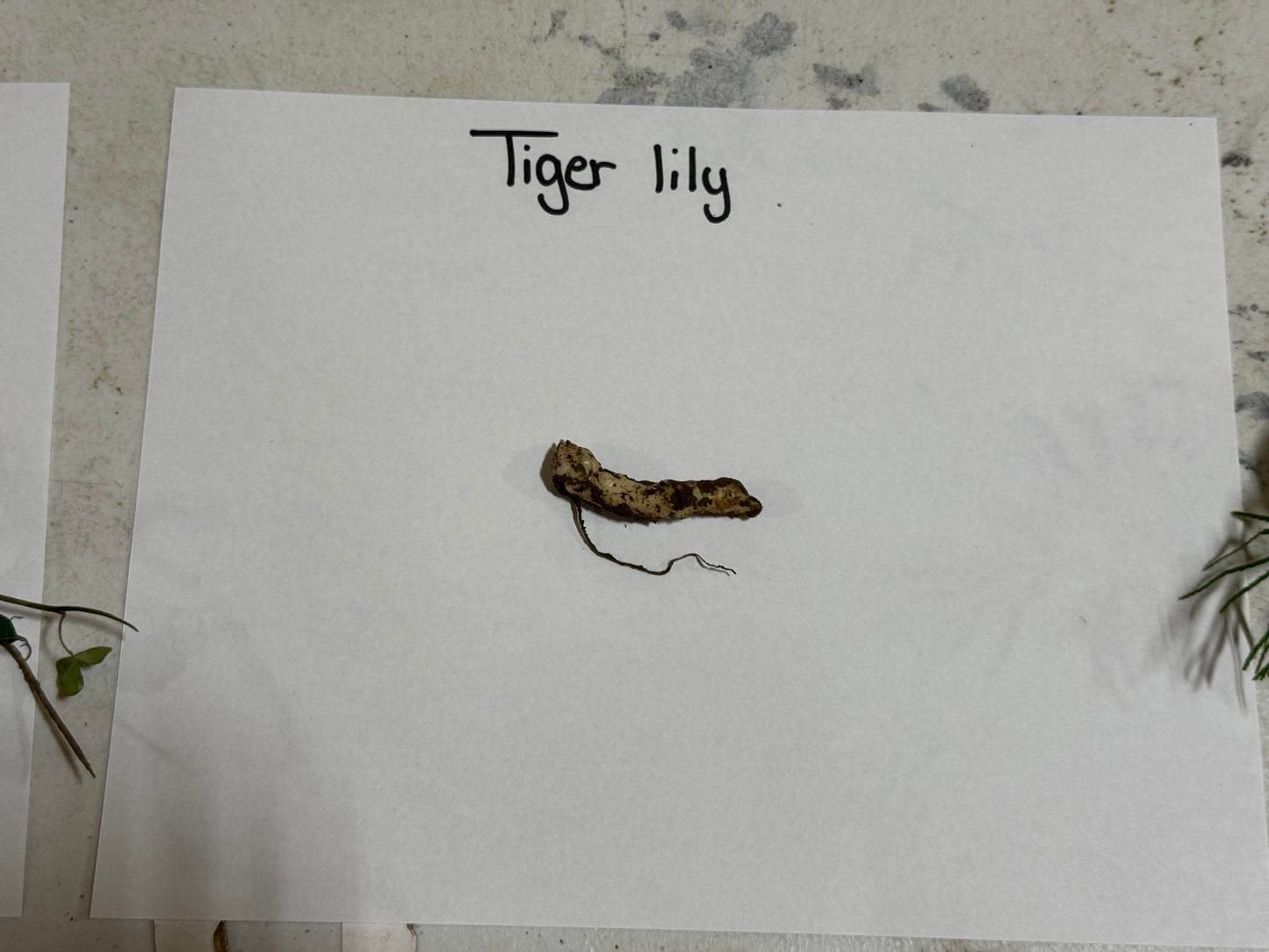Couldn't load pickup availability
🌸When you add 1 plant to cart, it automatically adds the free one
Buy Tiger Lily Plants - Lilium Lancifolium
While originating from China, the Russian Far East, and Korea, the tiger lily has become a favorite among North American gardeners. It is regularly found neatly organized within a garden or as an escapee on road sides across the USA.
These showy flowers stand tall atop a leggy and leafy stem, reaching as tall as 6 feet. Their leaves are rich green in color and produce a glossy sheen while basking in the sun. The flowers emerge as a rich orange color with dark brown spots across the petal surface. These flowers are not only visually beautiful and vibrant, but their texture is thick, supple and silky. Another sensory experience to enjoy. They will be a dazzling addition to your garden.
Plant Details - Tiger Lily Plants
Family: Liliaceae
Hardiness Zones: 3 to 9
Light Requirement: Full sun to partial shade
Water Needs: Moderate
Height: 3 to 5 ft
Spread: 1 ft
Growth Rate: Moderate
Bloom Time: Mid to late summer
Flower Color: Bright orange with dark spots
Wildlife Value: Attractive to pollinators
The Tiger Lily is a perennial plant that reliably flowers year after year. It blooms in mid- to late summer, and due to its height, it makes a great border plant.
These bold perennials grow well in containers and in the garden, making them a versatile option for plant lovers regardless of their living situation. Their robust stems and showy flowers make them ideal cut flowers to add to your perennial bouquet.
Landscape Uses and Maintenance - Tiger Lily Plants
They prefer moist, well-drained soil. While they thrive in full sun, they struggle in dry conditions so water them regularly. That being said, they are highly disease-resistant, making them a great option for beginner gardeners.
These plants are best planted in groups of three bulbs in the spring or fall. Grouping them will ensure a dense and impressive display once in bloom. You can consider staking for support if you want them to maintain their upright nature without toppling later in the growth cycle. However, lilies are stem-rotting and once they fall over, they will continue to grow with a reinvigorated root systems wherever their stem touches the ground.
Noteworthy Characteristics of Tiger Lily Plants
Attractive to pollinators, large orange flowers, easy to grow.
Adding these stately, tall flowers to your garden will make you, and all the pollinators, look forward to the spring. Shop for Tiger Lily plants online at TN Nursery. For 68 years, we have served the landscaping industry and homeowners with specimen plants.
This Is How Your Plants Will Look upon Delivery

Bloom Season
Summer
Bloom/Foliage Color
Orange
Height at Maturity
Over 12"
Care
Tiger Lilies thrive in well-drained soil and benefit from regular watering. Deadhead spent blooms to encourage more flowers. After flowering, allow the greenery to die naturally before cutting it down. Fertilize annually with a balanced fertilizer.
Plant Reproduction
Tiger Lily spreads by bulbils, which are small bulbs.
How to Grow and Care for Bare Root Perennials, Tubers, and Bulbs
Bare root perennials, tubers, and bulbs are an easy and economical way to jumpstart your garden with lasting beauty. These dormant plants should be planted in early spring or fall while the soil is cool and workable. Before planting, soak bare roots in water for 1–2 hours to rehydrate them. Choose a location based on the plant’s light needs—most flowering types prefer full sun, while others thrive in partial shade.
For bare root perennials, dig a shallow hole and spread the roots out naturally, ensuring the crown is level with the soil surface. For tubers and bulbs, plant with the pointed side facing up at a depth about two to three times their height. Cover with soil, gently press down, and water thoroughly.
Keep soil consistently moist (not soggy) until new growth appears. Add mulch to retain moisture and suppress weeds, but avoid covering the crown or bulb tops. Once established, these plants require little maintenance—just seasonal watering, occasional dividing, and deadheading or pruning as needed. With proper care, they’ll return and thrive year after year.
Shipping date depends on the date displayed and chosen when you order from the product's page.
We only accept returns on plants verified dead. If you think your plants have died, we offer a 1 year warranty, please use use this File a Claim Link to verify dead plants and start with return warranty process.




Caring Tips
How do I care for my Tiger Lily?
Each box contains detailed care instructions and information about your product. But here's the basics.
Care Tips
Tiger Lilies thrive in well-drained soil and benefit from regular watering. Deadhead spent blooms to encourage more flowers. After flowering, allow the greenery to die naturally before cutting it down. Fertilize annually with a balanced fertilizer.
Light Requirements
Tiger Lily (Lilium lancifolium) thrives in full sun to partial shade. For optimal growth and vibrant blooms, ensure it acquires at least 6 hours of direct sunlight daily. It can handle partial shade but may produce fewer flowers in lower light.
Hardy Planting Zones
3 • 4 • 5 • 6 • 7 • 8 • 9
I love how resilient these Tiger Lilies are—they thrived in my slightly shady patch. Just a quick mulch in winter, and they return beautifully.
These Tiger Lilies delivered exactly what I hoped for—tall, bright blooms that repeat each year with little intervention. A reliable staple for any border.
Planted them in spring and by mid-summer they began to bloom richly. The spotted petals are eye-catching, and cleanup was simple afterward.
The flowers themselves were gorgeous, but several bulbs had scraped scales from tight packaging. They recovered, but I expected gentler treatment.
As a new gardener, I appreciate how hardy these lilies are. That said, it took over a month before I saw any growth, which felt slow. Still rooting for them.





